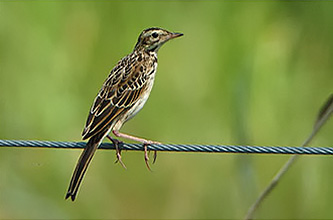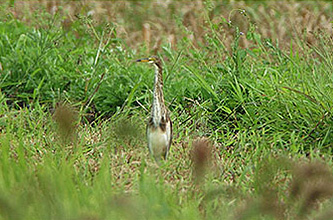 | E-mail to Birds Korea |
 | KWBS |
in the Region
 | The Oriental Bird Club |
 | BirdLife International (Asia) |
September
Temperatures begin to cool, especially towards the end of the month, with maxima often falling from 28°C to 20°C. Sunny, dry weather predominates, though often punctuated by occasional heavy rain and very strong winds associated with typhoons.
September sees migration pick up considerably, with a build-up of ducks including the first returning flocks of Baikal Teal by mid-month especially. Seabirds still provide much interest (with increasing numbers of jaegers and dark shearwaters), while shorebirds and Yellow Sea "specials" remain widespread and numerous: highlights have included the world's largest concentration of Spoon-billed Sandpipers (with a peak at Saemangeum of 200 in the late 1990s, likely 10% of the total world population), Nordmann's Greenshank, and up to 170 Black-faced Spoonbill at Ganghwa.
Whiskered and White-winged Black Terns, although scarce in South Korea, become rather more widespread with small flocks of the latter at Seosan especially, along with an increasing number of Mongolian Gull. Raptor migration includes large concentrations of Chinese Sparrowhawk making their way towards Japan (where over 50 000 have been recorded in one day on an island in the Korean Straits only 40 km south of Busan!), along with smaller flocks of Grey-faced and Crested Honey Buzzards, and very small numbers of Pied Harrier and Amur Falcon especially through the west and northwest.
Passerines become rather more numerous and diverse, with Thick-billed Warbler and Brown Shrike early in the month, good numbers of Yellow Wagtail (including the highly attractive taivana), Pechora Pipit, and the three species of "grey-brown flycatchers" by mid-month (some Dark-sided and Brown still, with a peak in Grey-streaked). Towards the very end of September, Olive-backed and Buff-bellied Pipit migration starts in earnest, and the first small flocks of buntings also arrive, with most numerous being Chestnut and Black-faced.
September highlights include both Korean records of Rose-coloured Starling (2002 and 2004), 2 Eurasian Tree Pipits on Eocheong island in 2002, and in 2003, an Ashy Drongo on Socheong Island, with 1 or 2 South Polar Skua seen at sea nearby, Korea's first Steppe Grey Shrike (2004), and the country's first Dotterel, found at Seosan in 2005.
(The following records are a compilation of our own sightings and records sent in by other observers. As well as being posted on the Birds Korea website(s), selected records are also forwarded to other Korean-language birding websites; records of threatened species are arranged and forwarded to Birdlife International and national authorities when appropriate; flag images and records are passed to bodies responsible for their coordination throughout the flyway; and all records sent to us are used to compile annual reports and to support the evolving understanding of the status of many of Korea’s birds.)
SHRIKES. Sightings in South Korea this year have thrown up a number of very interesting questions regarding shrike identification in northern Asia. We now have three discussion papers online: Brown Shrikes, Presumed Steppe Grey Shrike, and Red-backed Shrike. As always, we would welcome comment and input from experienced observers.
MONGOLIAN GULLS. A German research team has flagged a number of Mongolian Gulls on their breeding grounds, and are requesting any details of winter sightings. Go to: Wing-flagged Mongolian Gulls.
Samcheok and Guryongpo, Chuseok Holiday Period
At Samcheok I saw a pair of Common Merganser in the river near the museum and from there I saw lots (thousands) of Black-tailed Gulls along the coast to Pohang and Guryongpo.
On the rocks near Guryongpo, foraging among the green algae between waves, were Sanderling (n=15), Grey-tailed Tattlers, and Common Sandpipers. In the southern part of the harbour I saw Greater Sand Plovers (2), Red-necked Stints (3), Dunlins (2) and WhiteWagtails. There were many Black-tailed Gulls and I saw some Vega and Black-headed Gulls. There was a single Common Teal near Hajang2ri.
Song Island, September 28
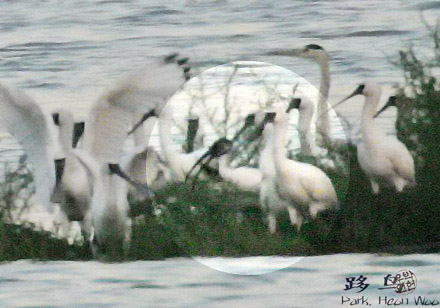
1 Oriental Ibis (probably a juvenile).
Rare in northeast Asia this is quite possibly only the second record for South Korea - and certainly the first record for the country in a number of years: interestingly KATAYAMA Shusaku also reported one at Yatabe, Hasaki-machi Ibaraki, Japan on October 03.
Geum-ji Village 50Km North of Jeon-ju, September 28
I enjoyed watching a Common Kingfisher near the reservoir. There I flushed at least three Striated Herons: one adult, two juveniles. On my way back just after the sun went behind the mountains, I saw three White-throated Needle-tailed Swifts hurdling back and forth over the grassy fields and gardens at the foot of the mountains there.
Flag Sighting:
One Ruddy Turnstone Arenaria interpres was sighted by Taiwan Wader Study Group at: Han-Bou, ChangHwa County, Taiwan 24deg 2min 0sec N, 120deg 22min 0sec E on 5/08/2004 with flag(s) as follows:
LEFT leg: nothing/unknown on tibia (upper) above metal band on tarsus; RIGHT leg: white flag on tibia (upper) above orange flag on tarsus
This bird was flagged in Korean Peninsula, approximate co-ordinates 36deg min S, 126deg 40min E, which uses the flag combination White/Orange, sometime since 1998.
The resighting was a distance of approximately 1462 km, with a bearing of 206 degrees, from the marking location.
TWSG report: R279
Processed 27/09/2004, our reference: 00006307 (UNK14069). Report sent to corresponder, with copy sent to observer.
Seosan, September 24
Baikal Teal have started to arrive in significant numbers. After two on September 5th, numbers had increased to 2 500 by the 18th, and 17 000 by September 24th.
Socheong Island, September 23
Another clear, sunny and cool dawn, with a low of 13 C. The morning's birding before the ferry crossing back to Incheon produced good views of at least 10 Chinese/Light-vented Bulbul still, ca 50 Chestnut-flanked White-eye, and at least 58 Crested Honey Buzzard and 2 more Pied Harrier moving west. A search for yesterday's grey shrike ended unsuccessfully, though 3 Jay were in the same area, another unexpected addition to the Socheong list.
From the ferry itself, a single South Polar Skua and 9 Pomarine Jaeger were obvious highlights, along with 4 Flesh-footed Shearwater, while no Swinhoe's Storm Petrels were logged, and only 66 terns (all closest birds being clearly non-breeding adult Commons). Of significant interest were the numbers of gulls: away from Socheong, over 1000 Black-tailed, 45 Mongolian and 10 taimyrensis were counted in open sea in a little over two hours, indicating significant movement into or through the area.
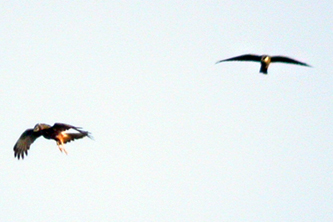
Socheong. © Nial Moores.
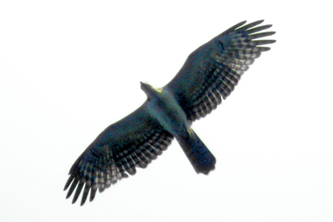
Socheong Island, September 22
The run of great birding continued, with 68 species logged despite the clear conditions. Visibility was very high (more than 100 km), and the morning temperature a refreshing 13C, stimulating significant diurnal movement.
A total of 57 Crested Honey Buzzard were watched moving west during the day, along with 3 Black Kite, 5 Pied Harrier and small numbers of the four accipiters: Japanese Lesser (10); Chinese (3), Northern Sparrowhawk (1); and Northern Goshawk (3), even though only one hour was actually spent raptor watching. In addition, single Little Ringed Plover, Spotted Redshank, and the autumn's personal first Woodcock were also logged, along with small numbers of Grey (20) and alba Wagtails (80) and at least 50 Asian House Martin and a similar number of Red-rumped/Lesser Striated Swallow.
Grounded migrants included 3 Red-throated Flycatcher, at least 4 Siberian Rubythroat, 100+ Chestnut-flanked White-eye and the briefest encounter with what was presumably the same Little Owl found and digiscoped by Park Jin-Young back on September 4th, flushed from a bush less than 100 m away from the original sighting.
Outstanding highlight came very late in the afternoon, however. A grey shrike was watched sitting half-obscured at the top of an almost inaccessible ridge. Wading through dense tangled grasses towards it, the bird flushed at very short range, but rather than flying a long way as expected, it simply perched up on top of the nearest pine tree where it remained for the next 5 minutes, at less than 20 m range. Although almost all views were head-on, it appears that this was rather likely an adult Steppe or Saxaul Grey Shrike Lanius (meridionalis) pallidirostris, a taxon as yet not formally claimed in South Korea.
A paper (with 15 images of grey shrikes) looking at this record has been posted (Sept 27th), with a request for comments from experienced observers. Go to Grey Shrikes.

Socheong. © Nial Moores.
Andong, September 23
4 Common Mergansers in the subsiduary dam near Andong Dam this morning. Looks like migration has started...
Hong Island, September 22-23
22nd: 80 Crested Honey Buzzard
23rd: 84 Crested Honey Buzzard
Socheong Island, September 21
With skies clearing overnight, followed however by a tremendous rainstorm at 4 am, many migrants appeared to have moved on.
Only ca 30 Yellow-browed Bunting were logged during the day, while other noteworthy species included at least 4 Yellow-legged Buttonquail, 4 Siberian Rubythroat and 2 Siberian Blue Robin, as well as single Thick-billed, 5 Brown and 5 Bull-headed Shrikes.
Three hours of raptor watching produced the personal first Northern Sparrowhawk of the autumn, ca 5 Northern Goshawk, 1 Pied Harrier and 42 Crested Honey Buzzard.
Outstanding highlight came shortly after dawn, however. While trying to get better views of a male Siberian Rubythroat and a Lanceolated Warbler, a large (near-Moorhen sized) crake flushed out of long grasses at the edge of some woodland. Flushing the bird a second time provided a much better second view, and all the neccessary detail: this was very strikingly a juvenile/immature Band-bellied Crake Porzana paykullii.
Although apparently about the sixth record for South Korea, this is the first record known to WBKE since 1962. Previous records are listed as follows.
Gyunggi Province
- 1962. 05. 29 - 1 individual (UCB); no record of the exact locatio.
- 1929. 11. 20 - 1 individual (Austin, 1948.
- 1920. 05. 20 - 1 individual (Austin, 1948.
- 1917. 07. 01 - 1 individual (Austin, 1948.
- 1913. 05. 31 - 1 individual (Austin, 1948.
Gangwon Province
- 1 individual (no exact date and year) (Austin, 1948.
September 20, Gangneung.
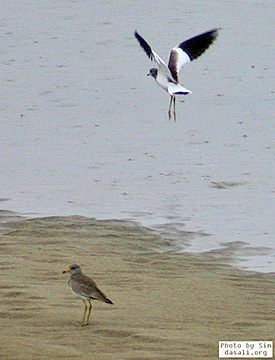
2 Grey-headed Lapwing
Flag Sighting:
A Great Knot Calidris tenuirostris was sighted by Arthur and Sheryl Keates at:
between Lee Pt. and Buffalo Ck. Beach, Darwin, NT, Australia 12deg 20min 5sec S, 130deg 54min 13sec E on 18/September/2004 with flag(s) as follows:
LEFT leg: nothing/unknown on tibia (upper) above metal band on tarsus; RIGHT leg: white flag on tibia (upper) above orange flag on tarsus
This bird was flagged in Korean Peninsula, approximate co-ordinates 36deg min S, 126deg 40min E, which uses the flag combination White/Orange, sometime since 1998.
The resighting was a distance of approximately 5394 km, with a bearing of 174 degrees, from the marking location.
Plumage described as: Partial Breeding.
The flagged individual had strong traces of breeding plumage.
This bird was seen in a flock of 2500 waders, composed mostly of Great (c.1700) and Red Knots (c. 100).
Geum River Estuary, September 20
In a small mixed group of Black and Bar-tailed Godwits, a single Broad-billed Sandpiper still in breeding plumage.
Socheong Island, September 20
Overcast overnight with rain and strengthening westerlies by 8 am appeared to force significant numbers of diurnal migrants down. Numbers were very difficult to estimate due to the weather conditions and the possibility of double-counting, but included an estimated 120 to 150 Yellow-browed and ca 75 Chestnut Buntings, at least 60 Chestnut-flanked White-eye (in one flock with several other smaller groups), 30+ Olive-backed and perhaps 10 Pechora Pipits, 3 Siberian Thrush, and perhaps 50 Black-naped Oriole.
Other species of note in the morning included the personal first Japanese Quail, Daurian Starling (2) and Black-browed Reed Warbler of the autumn, a Siberian Blue Robin, ca 14 Crested Honey Buzzard and a juvenile Black Kite, and the brief reappareance of yesterday's Marsh Harrier of unknown provenance, again at distance showing some dark eye-stripe and only limited white to the bases of the primaries.
Socheong Island, September 19
With clear and almost calm conditions, most of the day (0830-1700) was spent at the raptor watch point. Most numerous of the 10 raptor species logged were Japanese Lesser (57) and Chinese Sparrowhawks (52), with most noteworthy being a total of 10 Pied Harrier (one male, two females and seven juveniles): it appears increasingly obvious that this species is quite a regular migrant through the northwest of the country. In addition, 3 Northern Goshawk were the personal first of the autumn.
Most puzzling was a juvenile Marsh Harrier, either Eastern or Western (or possibly hybrid?), seen at 1700 hrs. On mid-distance flyby views, it appeared very dark, with a contrastingly pale head and slightly paler tail, and what appeared perhaps to be a hint of pale on the very leading edge of the wing. In addition, the head seemed to have a dark eye-stripe (though not as strong as would be expected on a pure Western), while on the underwing there was only a white comma at the primary bases (indicative of a Western). Following an "odd" Marsh Harrier at Seosan in late September 2003, subsequent correspondence revealed that Eastern and Western Marsh Harriers are considered to hybridise in some areas, producing some very tricky offspring (!)...
Other species of note seen during the day included a juvenile Chinese Egret, 17 White-throated Needletails, 5 Common Rosefinch, another Varied Tit and the personal first Chestnut-flanked White-eyes of the autumn (with three different flocks totalling ca 52 individuals), while an Oriental Scops Owl calling at night was also considered rather unusual.
near Seosan, September 19

with Common Greenshank,
near Seosan. © Kim Hyun-tae.
On Kim Hyun-tae's website today a superb series of photos of a Nordmann's (Spotted) Greenshank with a small flock of Common Greenshank, which clearly show the principal identification features used to separate the two species. (NB: Photos posted with permission)
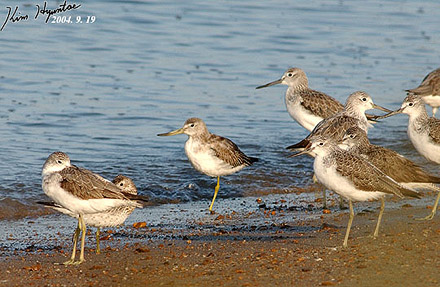
with Common Greenshanks,
near Seosan. © Kim Hyun-tae.
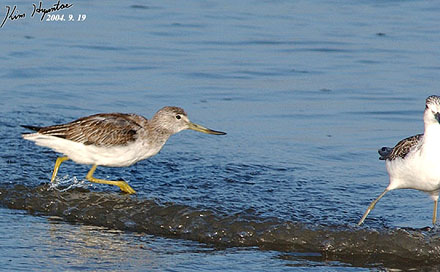
with Common Greenshank,
near Seosan. © Kim Hyun-tae.
Socheong Island, September 18
Despite the night being overcast with some spells of rain, few migrants appeared to have been grounded. Most noteworthy species during the day included 3 Pied Harrier (including one adult male), a male Blue-and-White Flycatcher (either cumatilis or intergrade with nominate) the personal first Buff-bellied Pipit (japonicus) and Pallas's Leaf Warbler of the autumn, and perhaps least expected of all a Varied Tit (the first record on Socheong Island of this largely sedentary species).
Socheong Island, September 17
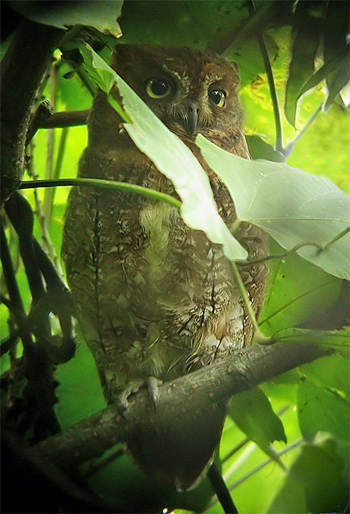
With fog largely breaking under clear skies overnight, quite a few of yesterday's birds appeared to have moved on. Best for the day included the personal first Red-throated Pipit of the autumn (with at least 10 moving west in the morning), 2 or 3 Common Rosefinch still, a single Grey-faced Buzzard, and a reddish Oriental Scops Owl found at roost.
Outstanding highlight, however, was Socheong Island's first Fairy Pitta, seen well but very briefly in the second village.
Socheong Island, September 16
With rain clearing by 1 am, followed by fog banks, it was evident that a small fall had taken place. 65 species were logged for the day, including 10 species of warbler (including the personal first Radde's of the autumn and probably 70+ Arctic and 50 Yellow-broweds) and 5 species of flycatcher (including a single Blue-and-White and the personal first Red-throated (Taiga) Flycatcher). Birds of most note included the personal first Olive-backed Pipit, Black-faced Bunting and migrant Red-rumped/Lesser Striated Swallows of the autumn, while good views were also had of both Gray's Grasshopper Warbler and Siberian Blue Robin: both very seldom seen migrants in autumn.
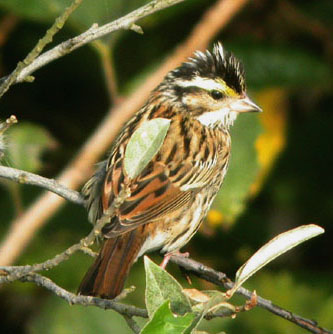
(presumed juvenile going into "first-winter"),
Socheong. © Nial Moores.
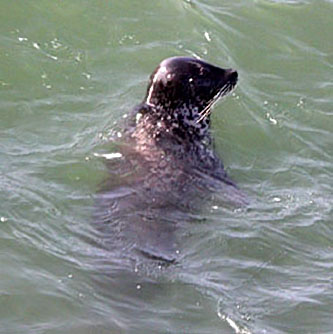
Hong Island, September 16
Park Jong-Gil found and photographed this striking first-year shrike on Hong Island in the far southwest of the country. Believing from field views that the bird was most likely to be a Red-backed Shrike Lanius collurio - a taxon which has not been recorded in South Korea before - he set his nets, caught the bird and took detailed measurements. A paper with a series of photographs has now been posted, and comment invited: go to Red-backed Shrike.
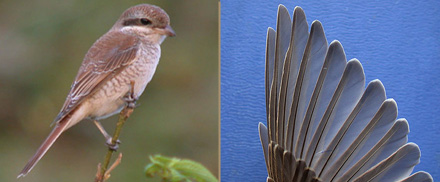
Nakdong estuary, Busan, September 15
At least 8 Spoon-billed Sandpiper were found during shorebird counts in the estuary. The Nakdong used to be the best site for the species in Korea, with a peak count of 200 in the late 1980s before construction of an estuary barrage. It is still likely regular there in small numbers.
Socheong Island, September 15
Very few grounded migrants and limited movement, with best being the Chinese Grey Shrike still, a Flesh-footed Shearwater offshore, one Blyth's and 4 Pechora Pipits, and the first Yellow-throated Bunting of the autumn on the island, found before torrential rain started to fall.
Socheong Island, September 14
In moderate southeasterlies some diurnal movement, but very few grounded migrants. Most numerous were White Wagtail (leucopsis) with ca 150 logged, Grey Wagtail (40), Barn Swallow (250+) and Asian House Martin (80).
Highlights included a single Northern House Martin (presumably the first record in South Korea since a series of sightings in 2003), the personal first Scaly/White's Thrush, Ashy Minivet (4) and Osprey of the autumn; and a Chinese Grey Shrike, tentatively aged as a juvenile/first winter (note especially the brown cast to the rear of the ear coverts).
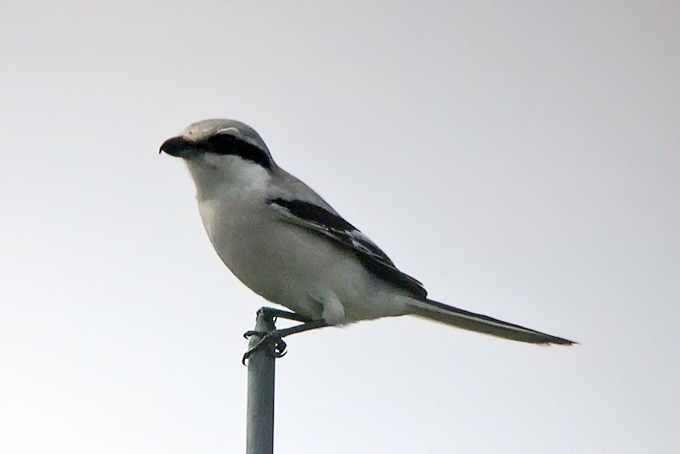
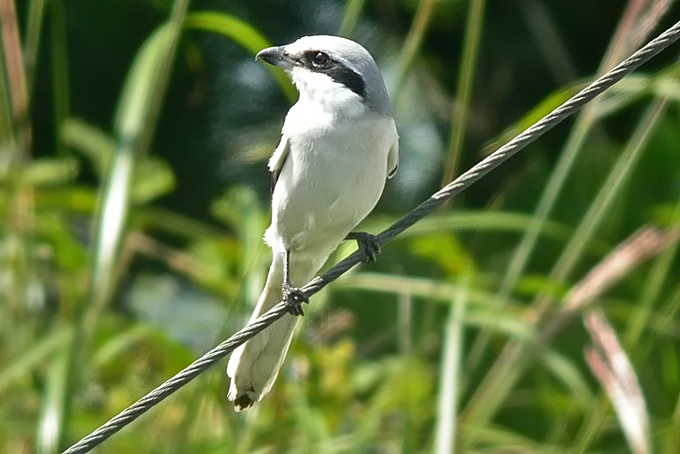
Mangyeong, September 11
At the Mangyoeng again today a pair of juvenile White-winged Black Terns, first working the rice fields and then going out over the water. In the rice fields, about 1.5 km from the sea wall, I saw a Chinese Great Grey Shrike - watched it for about 5 minutes from less than 50m in good light. It was a handsome bird: immaculate white below, gray rump, long tail, and lots of white in the wing. Not at all washed out like a couple of others I've seen.
Over on the south side of the Industrial Zone I picked up both Far-eastern and Eurasian Curlews, Ruddy Turnstones, Oystercatchers (about 3 dozen), and Kentish, Mongolian and Grey Plovers (Mongolian and Greys were also at the Mangyoeng).
Socheong Island to Incheon Ferry, September 9
With continuing clear skies and above average temperatures (perhaps reaching 30 C), few birds present on the island in the morning, with only a single Pied Harrier and ca 7 Common Rosefinch noted in the main village. From the ferry, rather smaller numbers of most species (e.g only 35 Streaked Shearwater and 54 Swinhoe's Storm Petrel), though increased diversity with two adult Taimyr Gulls Larus heuglini tamiyrensis (the personal first of the autumn), an adult Parasitic Jaeger (personal first of the autumn, though following one seen by Park Jin-Young on the same ferry on September 7th), and 3 Flesh-footed Shearwater.
Further highlights included 7 Pomarine Jaeger and even more noteworthy, the first 2 South Polar Skua of the autumn, while the majority of the 210 terns noted were too far off for confident identification. All closer individuals (ca 40) were considered to be Common Tern, though one juvenile seen reasonably well appeared to show clearly darker coverts contrasting with much paler, unmarked secondaries, a clear black trailing edge to the primaries, and an apparently "good" head pattern for Arctic Tern Sterna paradisaea (with apparently solid black around the eye). Although Arctic Tern breeds in NE Siberia, has been recorded in Japan and e.g. Viet Nam (pers obs) on migration, and winters in the southern Pacific, the species remains (even now!) unclaimed in Korean waters.
Socheong Island, September 8
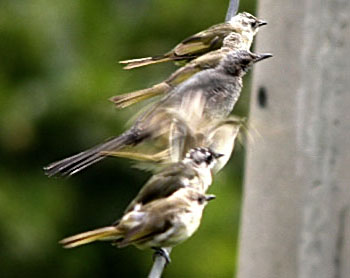
Socheong. © Nial Moores.
Missing out on the rain from the latest typhoon to affect South Korea, conditions remained sunny with winds easing to a light northwesterly. Few grounded migrants, and limited visible migration, with only 54 species logged.
Best for the day were 12 Common Rosefinch (probably a new national high count), 11 Chinese/Light-vented Bulbul together with 5 Brown-eared Bulbul, 4 more Pied Harrier (confirming its status as a regular migrant through the northwest), a single Amur Falcon, 4 Crested/Oriental Honey Buzzard, 2 more Pechora Pipit and 15 Asian House Martin. Only single Chestnut, Yellow-browed and Yellow-breasted Buntings suggest that bunting migration is still some time away...
Hong Island, September 6 - 7
1 juvenile Rose-coloured Starling Sturnus roseus.
(This is just the second record (and the first photographed), following the first on Eocheong Island on the notably similar date of September 01 2002 (Nial Moores, go to Rose-coloured Starling: new for Korea for details.)
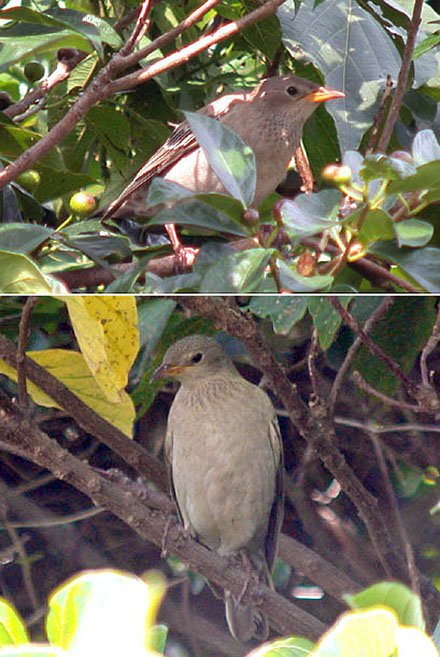
Joonam Reservoir, September 7
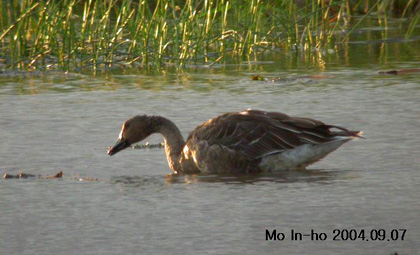
1 Taiga Bean Goose - the first at Joonam this autumn
Socheong Island, September 7
Remaining clear through the night, with increasing cloud and strengthening winds during the day. Very few grounded migrants, and little movement, with best being single Blyth's and 2 Pechora Pipits, ca 44 White-throated Needletail and 8 Asian House Martin, 15 Crested Honey Buzzard and 3 more Pied Harrier.
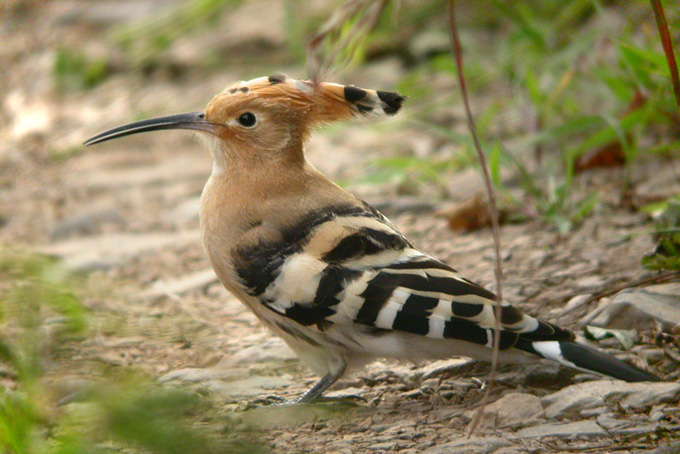
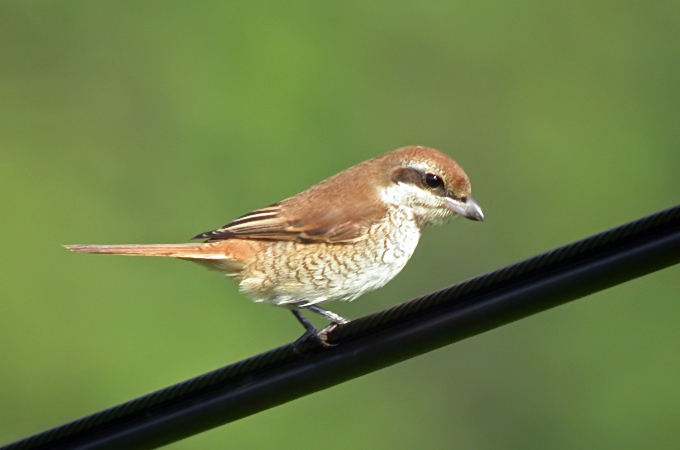
Socheong Island, September 6
Clear, sunny and hot, with very little movement. Best birds for the day were 2 close-flying adult male Amur Falcon, a single Pied Harrier, 55 Asian House Martin through, and the personal first Grey-faced Buzzard and migrant Black Kite of the autumn.
Rather more surprising was news of a second Little Owl, this time on Baekryong Island found (again!) by Park Jin-Young.
Mangyeong Estuary, September 5
A productive and interesting morning with cool temperatures and good light.
Amongst other records, about 15 juvenile White-winged Black Tern were working the rice fields just inside the sea wall. They trickled through over a period of 3 hours, moving up-river. Individual sightings: Chinese Little Bittern, Marsh Sandpiper, Common Redshank, Eurasian Hobby, and juvenile Eastern Marsh Harrier. There were flocks of Great Knots and many hundreds of Black-tailed Godwits (the most numerous bird of the day) but very few Bar-tailed Godwits. A group of 3 Common Snipe flew over and 3 Varied Tits showed up for a few minutes and then headed inland.
Socheong Island, September 5
Hazy sunshine and calm conditions giving way to light rain showers in the afternoon stimulated little migration, and numbers of birds were significantly lower.
Best were 25 Japanese Lesser Sparrowhawk and 15 Oriental Honey Buzzard over, along with 2 White-throated Needletail and 4 Asian House Martin, while after dark 6 Grey Nightjar and a Broad-billed Roller hawking insects at the edge of streetlights were the most enjoyable birds of the "day".
Other birds of note included a Pechora Pipit (giving the "chet" call thought likely typical of Menzbier's Pipit), 4 Thick-billed Shrike still, 10 Yellow-browed Warbler, 7 Grey-streaked Flycatcher (most of which were juveniles), 2 Common Rosefinch and ca 8 Black-naped Oriole.
Incheon ferry Socheong Island, September 4
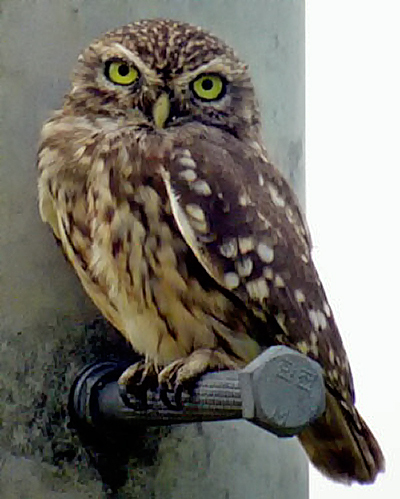
Another exciting ferry crossing in almost calm conditions, with 159 Swinhoe's Storm Petrel and 4 Pomarine Skua logged. Tern numbers were much reduced compared to 2 weeks previous, with only 84 logged in total, but these included two dark birds at medium to long range showing well upended rear ends...one of these was then watched taking flight, and showed the distinct appearance of a dark secondary trail on the underwing, combined with paler inner primaries and darker outer primaries: this underwing pattern is considered diagnostic of Aleutian Tern (This follows a first "Category 2" record last month: go to Aleutian Tern for details..
On the island itself, still ca 5 Chinese/Light-vented Bulbul still present, while the small numbers of grounded migrants included 2 Yellow-legged Buttonquail, 1 Swinhoe's and 5 Pintail Snipe, a Blyth's Pipit and 3 Thick-billed Warbler. Flyover migrants included 2 White-throated Needletail and probably 5 Pied Harrier (a female type, followed by a single juvenile and then 3 juveniles all in the space of 45 minutes).
Outstanding bird of the day though was a Little Owl Athene noctua, found and digiscoped by Park Jin-Young. There are very few records of this species in South Korea (the most recent one known to WBKE being one in the Saemangeum area in January 2002), and this is possibly the first photograph of the species from South Korea.
Seosan, September 4
6 Richard's Pipit and 1 Chinese Pond Heron
